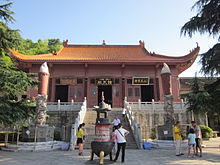Baiyun Temple (Ningxiang)
Name
The name of the Baiyun Temple derives from the view of temple shrouded by white clouds.
History

Tang dynasty (618–907)
In 858, in the twelfth year (858) of the age of Dazhong (847–860) of Tang Xuanzong (810–859) in the Tang dynasty (618–907), master Guang'en (光恩禅师) built Qinglin Temple (清林寺) in Su Rever, in Huilong Mountain (回龙山粟溪).
Ming dynasty (1638–1644)
Wang Bi (王陛) and his son Wang Weihan (王维汉) extended Baiyun Temple.
Qing dynasty (1644–1911)

In 1646, in the third year of the age of Shunzhi of Shunzhi Emperor (1638–1661), Tao Runai (陶汝鼐; 1601–1683) rebuilt Baiyun Temple.
In the period of the Qianlong Emperor (1736–1796), Wanxing (万行) rebuilt Baiyun Temple. In 1763, in the twenty-eighth year of the age of the Qianlong Emperor, Qinglin Temple and Baiyun Temple were consolidated and renamed "Baiyun Temple".
In the period of the Daoguang Emperor (1821–1850), the monks rebuilt Baiyun Temple.
People's Republic of China
In 1988, the People's Government of Ningxiang rebuilt Baiyun Temple. In 1989, the Ningxiang Buddhist Association was set up in Baiyun Temple.
References
- ^ Huang Haichao & Jiang Hongzhao (2002), p. 51.
- ^ 《白云寺香火鼎盛》 [Baiyun Temple, Here Incense Its Peak]. Ningxiang.net (in Chinese). Archived from the original on 2011-01-17. Retrieved 2009-12-17.
- ^ 宁乡白云寺长沙湖南寺院 [Ningxiang Baiyun Temple in Changsha, Hunan]. fjdh.cn (in Chinese). 2013-07-19.
Bibliography
- Huang Haichao; Jiang Hongzhao (2002-09-01). "Tourism: Famous Scenic Spots and Historical Sites" 旅游业:名胜古迹. 宁乡史地 [History and Geography of Ningxiang] (in Chinese). Haikou, Hainan: Nanfang Publishing House. ISBN 7-80660-538-X.